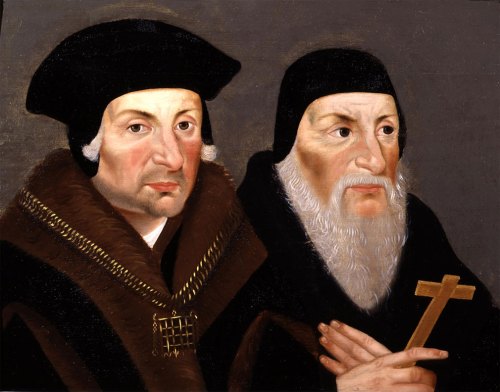Born in London in 1478, Thomas More studied classics and law, being called to the bar when he was twenty-three years old. His clear honesty and integrity impressed King Henry the Eighth, and he appointed Thomas as his Chancellor. Thomas supported the king in his efforts to reform the clergy but disagreed with the king over Henry’s disputes with the papacy, caused by the king’s desire to annul his marriage to Catherine of Aragon and to find another queen who might provide him with a male heir. Henry could stand no such act of defiance and imprisoned his Chancellor in the hope that he would abandon his opposition. Thomas accepted the Act of Supremacy, which declared the king to be the only protector and supreme head of the Church in England only with the qualification offered by Bishop John Fisher (see below). However, Thomas refused to take the Oath of the Act of Succession, which declared the nullity of Henry’s marriage to Catherine and required the king’s subjects to recognize the offspring of Henry and Anne Boleyn as the true successors to the throne. Thomas was executed for treason on this day in 1535, declaring that he died for the faith of the holy Catholic Church, and that he was “the king’s good servant but God’s first”.
John Fisher was Thomas More’s close friend and ally. A brilliant academic, he had substantially reformed the life of Cambridge University through the wealth and influence of his patron, Lady Margaret Beaufort, the mother of King Henry the Seventh. He was made bishop of Rochester and proved himself a good pastor to his small diocese, the ambassador of Emperor Charles the Fifth declaring him a paragon of Christian bishops for his learning and holiness. As with Thomas, Henry the Eighth admired him at first, but when he opposed the king their relationship deteriorated. When the king started to plan his divorce of Catherine, Fisher clearly demonstrated the validity of their marriage and showed that it could not legally be dissolved by any power on earth. A few years later he became the campion of the supremacy of the Church and of the pope, protesting in Convocation in 1531 against the king’s new title of “supreme head of the Church in England”, accepting the Act of Supremacy only with the insertion of the qualification, “so far as the law of Christ allows”. Like Thomas, he refused to take the oath of the Act of Succession because in the wording presented it was tantamount to an oath of Supremacy. He was thereafter imprisoned in the Tower of London on the king’s command. At sixty-six, and prematurely aged by his imprisonment (contemporaries commented that he looked more like eighty-six), he was tried for treason and found guilty. He was executed two weeks before Thomas on June 22, 1535. Despite his physical weakness, fortified by reference to the words of the seventeenth chapter of John, verses three and four, he pardoned his executioner, declared in a clear voice that he was dying for the faith of Christ’s holy Catholic Church, asked the people to pray for him, and recited Te Deum and a psalm.
More and Fisher were canonized by the Roman Catholic Church in 1935.
prepared from Celebrating the Saints
and The Oxford Dictionary of Saints
________________________________________________________
The Anglican weblog, Catholicity and Covenant, explores why Anglicans would commemorate these two Roman Catholic Reformation martyrs who opposed the separation of the Church of England from the papacy.

